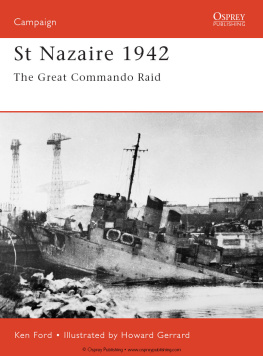18
WHEN HELBERG ARRIVED IN BRITAIN, EXPERTS IN LONDON WERE STILL assessing the damage done to the Vemork plant by the successful Gunner-side raid. Basing their estimates on the fact that it takes over a year for the whole electrolytic process, starting with ordinary water and ending with heavy water, to go through its various stages, they decided that heavy-water production had been set back about two years. Not only had the high-concentration cells in the last and most time-consuming stage of the process been destroyed, but also the high-concentration heavy water itself had escaped down the drains. The Germans could repair the damage and rebuild the high-concentration cells, but until those cells were filled again, drop by drop, with water from preceding stages in the process, there would be no high-concentration heavy water.
The Germans, though, worked day and night on the problem and on July 8, 1943, five months after the Gunnerside raid, Einar Skinnarland, who had set up a radio station powered by a makeshift water wheel up on Hardanger Plateau, reported to London that Vemork was expected to reach full production of heavy water again from August 15th, 1943" The Germans had accomplished this, Skinnarland explained in another message, by bringing some of the heavy water they had already taken from the plant back from Germany and filling the emptied heavy-water installations with it so that the whole process in all its stages could be started again. On August 3, 1943, he reported that partial production of the 99.5% heavy-water concentrate started in June and that the output has now reached 4.5 kilos [about 10 pounds] per day.
During this period, there were exchanges between London and Skinnarland about sabotaging the production by adding small amounts of vegetable oil to the distillation vats. London requested that this be tried without endangering the security of the contacts inside the plant.
On August 9, Skinnarland reported that the daily production at times had been reduced to 1.5 kilos [about 3 pounds] as a result of adding oil to the distillation vats.
These sabotage efforts did not, however, satisfy General Leslie Groves, in Washington, especially after he learned that shipments of heavy water from Vemork to Germany were now being made under very heavy guard. That these shipments were irreducibly small only added to Grovess determination to have them stopped altogether. What better evidence was there that the Germans were close to solving their uranium problem than the protection they were giving every pound of heavy water extracted from the Vemork plant?
After some discussion of launching another commando raida full-scale one this time, Groves wrote in Now It Can Be Told, General Marshall, at my behest, proposed to [Field Marshal] Sir John Dill [of the Combined Policy Committee set up to supervise the joint efforts of the United States, the united Kingdom, and Canada] that, instead, the plant be made a first priority bombing objective.
From the start, Tronstad and Wilson had been vehemently opposed to an air bombardment of the Vemork plant, but this time neither of them nor the Norwegian government in exile was consulted. It was decided by the Combined Chiefs of Staff, after careful consideration, according to the British account as recorded in Norsk-Hydro, published in Oslo in 1955, that the objective was better suited to bombing that to sabotage. The British Government [has] received information from sources worthy of confidence to the effect that the Germans [have] strengthened their security to the point where it would be impossible to carry out sabotage operations. In future they would have no success at all.
In view of the brilliant precision-bombing record established by the United States Army Air Forces daylight bombers in different war theaters, the Combined Chiefs chose the U.S.s Eighth Air Force in Britain, under the command of General Ira C. Eaker, to execute the operation. After studying maps of the gorge cut by the Mne River, the mountains rising like walls on each side, and the snug, cliffside location of the plant, Eaker expressed no great confidence that the target could be destroyed by bombing. But by then, November 1943, America had made such advances toward constructing an atomic bomb that Groves wanted at all costs to prevent the Germans from making one first. In the end, the urgency, stakes, and logistics involved made a bombing attempt the inevitable choice.
When the bombers climbed into the air over Britain in the pre-dawn hours on November 16, the weather was bad, with cloud banks as low as 500 feet and as high as 10,000 feet, serious icing conditions, and high turbulence. There were 460 aircraft altogether, Flying Fortresses and Liberators of the VIII Bomber Command, and they were all heavily loaded with the extra fuel needed for the return trip. To diffuse any possible retaliation by German fighters, it was to be a three-pronged attack. Two divisions were to attack targets near Stavanger and Oslo respectively. The third division, under the command of Major John M. Bennett, would concentrate on Vemork.
One by one, in rapid succession, they took off and climbed into the clouds and darkness, where they stacked up in circling layers, at predetermined altitudes, until they formed groups and squadrons for the flight across the North Sea. The Vemork plant was to be attacked between 11:30 A.M. and noon, when most of the workers would be at lunch, and the forecast for southern Norway during that time span called for clear skies, with clouds closing in shortly thereafter.
It was daylight when the third division, in standard box formations, headed out over the North Sea at 14,000 feet. German fighters were expected, but none were encountered. In fact, the flight across the sea was so uneventful that they reached the Norwegian coast, between Kristiansand and Stavanger, eighteen minutes ahead of time. Major Bennett, reluctant to strike the plant before the workers left for lunch, ordered the whole formation to turn back and circle over the sea for eighteen minutes. It was one of those command decisions that can haunt a man for years after a war is over. For when the Flying Fortresses turned and approached the Norwegian coast again, they were met by intense antiaircraft fire from alerted enemy defenses. One bomber was set afire, and another, forced out of its formation pattern with a blasted engine, started homeward. Ten men were seen parachuting from the flaming bomber into the sea as Bennett, in the command plane, led the way over a puzzling network of mountains, valleys, woods, and fjords toward the target.
The most precise navigation was required, and at 11:30 A.M. the bombardiers in the lead formation had the Vemork plant in their Norden sights. From the altitude of over two miles, the first pattern of bombs started downward. During the next thirty-three minutes, over 700 500-pound bombs fell in the deep valley where Norsk Hydro made its precious heavy water. They fell toward a target suddenly obscured by the emission of turbid smoke from the smoke generators erected by the Germans after the Gunnerside raid. This smoke made it difficult, if not impossible, to concentrate the attack on vital installations. The bombs fell everywhere, one scoring a direct hit on a newly built air-raid shelter; sixteen Norwegians were killed.
Four bombs struck the power plant, but they caused remarkably little damage to the machinery. Five houses and four troops huts were destroyed, and three others houses damages. The penstocks were hit by three bombs, and the sluices on top of the mountain were struck by two. Only the automatic closing of the sluice gates prevented a flood disaster for those caught on the ledge of rock on which the plant stood. They were more than caught; they were completely cut off, for a direct hit collapsed the suspension bridge over the gorge, while another tore up the railroad tracks leading from the plant along the shelf of rock into Rjukan.










